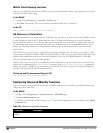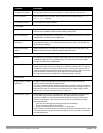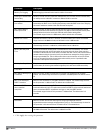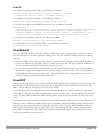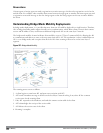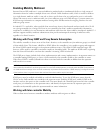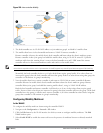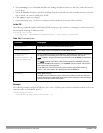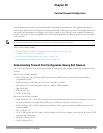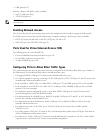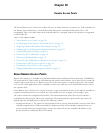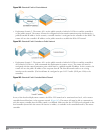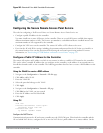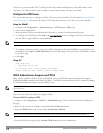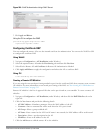
DellPowerConnectW-SeriesArubaOS6.2 | User Guide ExternalFirewallConfiguration | 507
Chapter 29
External Firewall Configuration
In many deployment scenarios, an external firewall is situated between Dell devices. This appendix describes the
network ports that need to be configured on the external firewall to allow proper operation of the Dell network. You
can also use this information to configure session ACLs to apply to physical ports on the controller for enhanced
security. Note, however, that this appendix does not describe requirements for allowing specific types of user traffic
on the network.
NOTE: A controller uses both its loopback address and VLAN addresses for communications with other network elements. If the
firewall uses host-specific ACLS, those ACLs must specify all IP addresses used on the controller.
Topics in this chapter include:
l "Understanding Firewall Port Configuration Among Dell Devices" on page 507
l "Enabling Network Access" on page 508
l "Ports Used for Virtual Internet Access (VIA)" on page 508
l "Configuring Ports to Allow Other Traffic Types" on page 508
Understanding Firewall Port Configuration Among Dell Devices
This section describes the network ports that need to be configured on the firewall to allow proper operation of the
network.
Between any two Dell controllers:
l IPSec (UDP ports 500 and 4500) and ESP (protocol 50). PAPI between a master and a local controller is
encapsulated in IPSec.
l IP-IP (protocol 94) and UDP port 443 if Layer-3 mobility is enabled.
l GRE (protocol 47) if tunneling guest traffic over GRE to DMZ controller.
l IKE (UDP 500).
l ESP (protocol 50).
l NAT-T (UDP 4500).
Between an AP and the controller:
l PAPI (UDP port 8211). If the AP uses DNS to discover the LMS controller, the AP first attempts to connect to
the master controller. (Also allow DNS (UDP port 53) traffic from the AP to the DNS server.)
l PAPI (UDP port 8211). All APs running as Air Monitors (AMs) require a permanent PAPI connection to the
master controller.
l FTP (TCP port 21).
l TFTP (UDP port 69) all APs, if there is no local image on the AP (for example, a new AP) the AP will use TFTP
to retrieve the initial image.
l SYSLOG (UDP port 514).
l PAPI (UDP port 8211).



